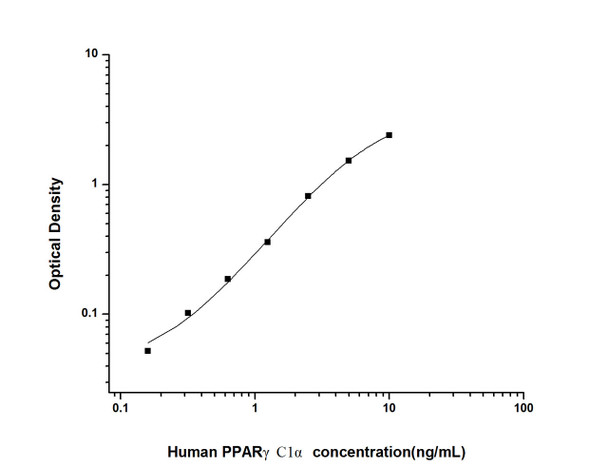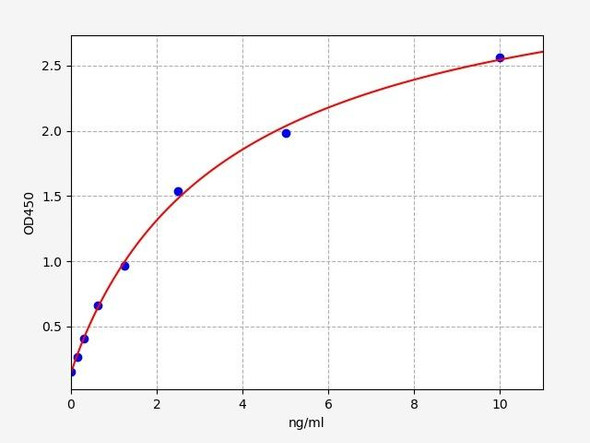Human Cell Biology ELISA Kits 6
Human PPARgammaC1 alpha (Peroxisome Proliferator Activated Receptor Gamma Coactivator 1 Alpha) ELISA Kit (HUES02404)
- SKU:
- HUES02404
- Product Type:
- ELISA Kit
- Size:
- 96 Assays
- Uniprot:
- Q9UBK2
- Sensitivity:
- 0.09ng/mL
- Range:
- 0.16-10ng/mL
- ELISA Type:
- Sandwich
- Synonyms:
- PPARGC1A , LEM6, PGC-1(alpha) , PGC-1v, PGC1, PGC1A, PPARGC1
- Reactivity:
- Human
- Sample Type:
- Serum, plasma and other biological fluids
- Research Area:
- Cell Biology
Description
| Assay type: | Sandwich |
| Format: | 96T |
| Assay time: | 4.5h |
| Reactivity: | Human |
| Detection Method: | Colormetric |
| Detection Range: | 0.16-10 ng/mL |
| Sensitivity: | 0.10 ng/mL |
| Sample Volume Required Per Well: | 100µL |
| Sample Type: | Serum, plasma and other biological fluids |
| Specificity: | This kit recognizes Human PPARgammaC1 alpha in samples. No significant cross-reactivity or interference between Human PPARgammaC1 alpha and analogues was observed. |
This ELISA kit uses Sandwich-ELISA as the method. The micro ELISA plate provided in this kit has been pre-coated with an antibody specific to Human PPARgammaC1 alpha. Standards or samples are added to the appropriate micro ELISA plate wells and combined with the specific antibody. Then a biotinylated detection antibody specific for Human PPARgammaC1 alpha and Avidin-Horseradish Peroxidase (HRP) conjugate are added to each micro plate well successively and incubated. Free components are washed away. The substrate solution is added to each well. Only those wells that contain Human PPARgammaC1 alpha, biotinylated detection antibody and Avidin-HRP conjugate will appear blue in color. The enzyme-substrate reaction is terminated by adding Stop Solution and the color turns yellow. The optical density (OD) is measured spectrophotometrically at a wavelength of 450 nm ± 2 nm. The OD value is proportional to the concentration of Human PPARgammaC1 alpha. The concentration of Human PPARgammaC1 alpha in samples can be calculated by comparing the OD of the samples to the standard curve.
| UniProt Protein Function: | PGC-1 alpha: a transcriptional coactivator for steroid receptors and nuclear receptors. Greatly increases the transcriptional activity of PPARG and thyroid hormone receptor genes. Interacts with, and regulates the activities of, cAMP response element binding protein (CREB) and nuclear respiratory factors (NRFs). Regulates many genes involved in energy metabolism. Provides a direct link between external physiological stimuli and the regulation of mitochondrial biogenesis, and is a major factor that regulates muscle fiber type determination. Plays an essential role in metabolic reprogramming in response to dietary availability through coordination of the expression of a wide array of genes involved in glucose and fatty acid metabolism. May be involved in controlling blood pressure, regulating cellular cholesterol homoeostasis, and the development of obesity. Its transcription is repressed by ZNF746 which binds to 'insulin response sequences' in its promoter. Heavily acetylated by GCN5 and biologically inactive under conditions of high nutrients. Deacetylated by SIRT1 in low nutrients/high NAD conditions. |
| UniProt Protein Details: | Protein type:Nuclear receptor co-regulator; Transcription, coactivator/corepressor Chromosomal Location of Human Ortholog: 4p15. 2 Cellular Component: DNA-directed RNA polymerase II, core complex; intracellular membrane-bound organelle; nucleoplasm; nucleus Molecular Function:chromatin DNA binding; DNA binding; ligand-dependent nuclear receptor binding; ligand-dependent nuclear receptor transcription coactivator activity; protein binding; RNA binding; sequence-specific DNA binding; transcription coactivator activity; transcription factor binding; ubiquitin protein ligase binding Biological Process: brown fat cell differentiation; cellular respiration; circadian regulation of gene expression; circadian rhythm; digestion; mitochondrion organization and biogenesis; mRNA processing; negative regulation of neuron apoptosis; positive regulation of fatty acid oxidation; positive regulation of gluconeogenesis; positive regulation of histone acetylation; positive regulation of transcription factor activity; positive regulation of transcription from RNA polymerase II promoter; positive regulation of transcription, DNA-dependent; protein complex assembly; protein stabilization; regulation of circadian rhythm; regulation of transcription, DNA-dependent; response to muscle activity; RNA splicing; thermoregulation; transcription initiation from RNA polymerase II promoter |
| NCBI Summary: | The protein encoded by this gene is a transcriptional coactivator that regulates the genes involved in energy metabolism. This protein interacts with PPARgamma, which permits the interaction of this protein with multiple transcription factors. This protein can interact with, and regulate the activities of, cAMP response element binding protein (CREB) and nuclear respiratory factors (NRFs). It provides a direct link between external physiological stimuli and the regulation of mitochondrial biogenesis, and is a major factor that regulates muscle fiber type determination. This protein may be also involved in controlling blood pressure, regulating cellular cholesterol homoeostasis, and the development of obesity. [provided by RefSeq, Jul 2008] |
| UniProt Code: | Q9UBK2 |
| NCBI GenInfo Identifier: | 47117335 |
| NCBI Gene ID: | 10891 |
| NCBI Accession: | Q9UBK2. 1 |
| UniProt Secondary Accession: | Q9UBK2,Q3LIG1, Q4W5M7, Q9UN32, B7Z406, G8DM16, I3RTT5 I3RTT6, I3RTT7, I3RTT8, I3RTT9, |
| UniProt Related Accession: | Q9UBK2 |
| Molecular Weight: | 91kDa |
| NCBI Full Name: | Peroxisome proliferator-activated receptor gamma coactivator 1-alpha |
| NCBI Synonym Full Names: | PPARG coactivator 1 alpha |
| NCBI Official Symbol: | PPARGC1A |
| NCBI Official Synonym Symbols: | LEM6; PGC1; PGC1A; PGC-1v; PPARGC1; PGC-1alpha; PGC-1(alpha) |
| NCBI Protein Information: | peroxisome proliferator-activated receptor gamma coactivator 1-alpha |
| UniProt Protein Name: | Peroxisome proliferator-activated receptor gamma coactivator 1-alpha |
| UniProt Synonym Protein Names: | Ligand effect modulator 6 |
| Protein Family: | Peroxisome proliferator-activated receptor gamma coactivator |
| UniProt Gene Name: | PPARGC1A |
As the OD values of the standard curve may vary according to the conditions of the actual assay performance (e. g. operator, pipetting technique, washing technique or temperature effects), the operator should establish a standard curve for each test. Typical standard curve and data is provided below for reference only.
| Concentration (ng/mL) | O.D | Average | Corrected |
| 10 | 2.444 2.468 | 2.456 | 2.396 |
| 5 | 1.585 1.589 | 1.587 | 1.527 |
| 2.5 | 0.877 0.865 | 0.871 | 0.811 |
| 1.25 | 0.403 0.435 | 0.419 | 0.359 |
| 0.63 | 0.257 0.237 | 0.247 | 0.187 |
| 0.32 | 0.168 0.156 | 0.162 | 0.102 |
| 0.16 | 0.105 0.119 | 0.112 | 0.052 |
| 0 | 0.052 0.068 | 0.06 | -- |
Precision
Intra-assay Precision (Precision within an assay): 3 samples with low, mid range and high level Human PPARgammaC1 alpha were tested 20 times on one plate, respectively.
Inter-assay Precision (Precision between assays): 3 samples with low, mid range and high level Human PPARgammaC1 alpha were tested on 3 different plates, 20 replicates in each plate.
| Intra-assay Precision | Inter-assay Precision | |||||
| Sample | 1 | 2 | 3 | 1 | 2 | 3 |
| n | 20 | 20 | 20 | 20 | 20 | 20 |
| Mean (ng/mL) | 0.51 | 1.32 | 4.51 | 0.47 | 1.43 | 4.38 |
| Standard deviation | 0.03 | 0.06 | 0.15 | 0.03 | 0.08 | 0.19 |
| C V (%) | 5.88 | 4.55 | 3.33 | 6.38 | 5.59 | 4.34 |
Recovery
The recovery of Human PPARgammaC1 alpha spiked at three different levels in samples throughout the range of the assay was evaluated in various matrices.
| Sample Type | Range (%) | Average Recovery (%) |
| Serum (n=5) | 88-101 | 96 |
| EDTA plasma (n=5) | 94-107 | 101 |
| Cell culture media (n=5) | 95-109 | 101 |
Linearity
Samples were spiked with high concentrations of Human PPARgammaC1 alpha and diluted with Reference Standard & Sample Diluent to produce samples with values within the range of the assay.
| Serum (n=5) | EDTA plasma (n=5) | Cell culture media (n=5) | ||
| 1:2 | Range (%) | 96-114 | 91-104 | 95-109 |
| Average (%) | 104 | 97 | 101 | |
| 1:4 | Range (%) | 88-105 | 79-93 | 83-93 |
| Average (%) | 96 | 85 | 88 | |
| 1:8 | Range (%) | 89-102 | 82-94 | 86-100 |
| Average (%) | 95 | 89 | 93 | |
| 1:16 | Range (%) | 86-102 | 80-90 | 89-103 |
| Average (%) | 93 | 85 | 95 |
An unopened kit can be stored at 4°C for 1 month. If the kit is not used within 1 month, store the items separately according to the following conditions once the kit is received.
| Item | Specifications | Storage |
| Micro ELISA Plate(Dismountable) | 8 wells ×12 strips | -20°C, 6 months |
| Reference Standard | 2 vials | |
| Concentrated Biotinylated Detection Ab (100×) | 1 vial, 120 µL | |
| Concentrated HRP Conjugate (100×) | 1 vial, 120 µL | -20°C(shading light), 6 months |
| Reference Standard & Sample Diluent | 1 vial, 20 mL | 4°C, 6 months |
| Biotinylated Detection Ab Diluent | 1 vial, 14 mL | |
| HRP Conjugate Diluent | 1 vial, 14 mL | |
| Concentrated Wash Buffer (25×) | 1 vial, 30 mL | |
| Substrate Reagent | 1 vial, 10 mL | 4°C(shading light) |
| Stop Solution | 1 vial, 10 mL | 4°C |
| Plate Sealer | 5 pieces | |
| Product Description | 1 copy | |
| Certificate of Analysis | 1 copy |
- Set standard, test sample and control (zero) wells on the pre-coated plate and record theirpositions. It is recommended to measure each standard and sample in duplicate. Note: addall solutions to the bottom of the plate wells while avoiding contact with the well walls. Ensuresolutions do not foam when adding to the wells.
- Aliquot 100µl of standard solutions into the standard wells.
- Add 100µl of Sample / Standard dilution buffer into the control (zero) well.
- Add 100µl of properly diluted sample (serum, plasma, tissue homogenates and otherbiological fluids) into test sample wells.
- Cover the plate with the sealer provided in the kit and incubate for 90 min at 37°C.
- Aspirate the liquid from each well, do not wash. Immediately add 100µL of BiotinylatedDetection Ab working solution to each well. Cover the plate with a plate seal and gently mix. Incubate for 1 hour at 37°C.
- Aspirate or decant the solution from the plate and add 350µL of wash buffer to each welland incubate for 1-2 minutes at room temperature. Aspirate the solution from each well andclap the plate on absorbent filter paper to dry. Repeat this process 3 times. Note: a microplatewasher can be used in this step and other wash steps.
- Add 100µL of HRP Conjugate working solution to each well. Cover with a plate seal andincubate for 30 min at 37°C.
- Aspirate or decant the solution from each well. Repeat the wash process for five times asconducted in step 7.
- Add 90µL of Substrate Reagent to each well. Cover with a new plate seal and incubate forapproximately 15 min at 37°C. Protect the plate from light. Note: the reaction time can beshortened or extended according to the actual color change, but not by more than 30min.
- Add 50 µL of Stop Solution to each well. Note: Adding the stop solution should be done inthe same order as the substrate solution.
- Determine the optical density (OD value) of each well immediately with a microplate readerset at 450 nm.






